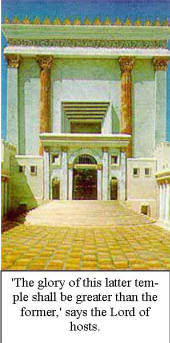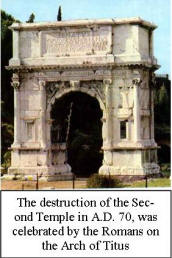
![]()
![]()
![]()
![]()
![]()
![]()
![]()
1.
Introduction to Judaism
2.
History of Judaism
3. The
Books of Judaism
4. The
Messiah according to Judaism
5. The
Messiah according to the Bible
6. Types of
the Messiah
Answering Objections
7. Isaiah 9:6-7, Isaiah 7:14
8. Isaiah 53 Part 1
9. Isaiah 53 Part 2
10 Daniel 9:24-27 Part 1
11. Daniel 9:24-27 Part 2
12. Psalm 2, 22
13. Haggai, Zechariah 12:10
13. Answering Jewish Objections to Haggai and Zechariah
|
|
|
|
Background to Haggai and Zechariah
In 586 B.C. the armies of Babylon, under Nebuchadnezzar destroyed the city of Jerusalem and the Temple built by Solomon, on the land purchased by King David, Mt. Moriah. The Temple, the very house of God on earth, destroyed by a pagan army was a sign to His people of His displeasure with their sin. 19 "But if you turn away and forsake My statutes and My commandments which I have set before you, and go and serve other gods, and worship them, 20 "then I will uproot them from My land which I have given them; and this house which I have sanctified for My name I will cast out of My sight, and will make it a proverb and a byword among all peoples. 2 Chronicles 7:19-20 The Temple was completed by Solomon in approximately 960 B.C., when it was completed the Shekinah, the presence of God occupied the Temple and sanctified it.
10
And it came to pass, when the priests came out of the holy place, that
the cloud filled the house of the Lord, 11 so that the priests could not
continue ministering because of the cloud; for the glory of the Lord
filled the house of the Lord. This was a very significant event, Godís very presence entered His Holy Temple, the Jewish Encyclopedia sheds light on this understanding of Shekinah.
In the Targumim.[1]
Nature of the Shekinah. The importance of the Temple and its relationship with the nation of Israel cannot be understated. Prior to the Temple, Godís presence dwelt in the Tabernacle, So Israelís history stretching back to the Exodus revolves around the Arc of the Covenant and the Temple, which housed the Arc. From the Time of Solomon, to the destruction of the Second Temple in A.D. 70, Israelís history can be divided into Temple Periods. The First Temple Period, lasted from approximately 960 B.C. to 586 B.C., the Second Temple from 516 B.C. to A.D. 70. Zechariah, Haggai and Malachi were the prophets of the Second Temple period. They wrote to encourage Israel and Judah, after they were allowed to return to the land. Central to both Haggai and Zechariah was the Temple and its reconstruction. The Second Temple construction was started about 536 B.C., but because of political intrigue on the part of those opposed to Jewish presence and a Temple in Jerusalem, construction was stalled. The Lord sent both Haggai and Zechariah to encourage Israel to start Temple construction. The Second Temple was less glorious in its physical appearance then Solomonís Temple, at its completion those who remembered the First Temple, regarded the second as inferior. 3 'Who is left among you who saw this temple in its former glory? And how do you see it now? In comparison with it, is this not in your eyes as nothing? Haggai 2;3 The Second Temple lacked the Shekinah, it also lack the Arc of the Covenant, but the Second Temple was promised to have a greater glory then the first. How and when did the Second Temple have greater glory then the first? The Second Temple was destroyed in A.D. 70? 6 "For thus says the Lord of hosts: 'Once more (it is a little while) I will shake heaven and earth, the sea and dry land; 7 'and I will shake all nations, and they shall come to the Desire of All Nations, and I will fill this temple with glory,' says the Lord of hosts. 8 'The silver is Mine, and the gold is Mine,' says the Lord of hosts. 9 'The glory of this latter temple shall be greater than the former,' says the Lord of hosts. 'And in this place I will give peace,' says the Lord of hosts." Haggai 2:6-9 How could the 2nd Temple be more glorious then the 1st Temple? The Messiah, who is God incarnated as man was at the Second Temple, when Jesus Christ, entered His Temple, as opposed the First Temple, which had limited access to the Shikinah, here Godís presence in the Messiah entered and became the sacrifice of the 2nd Temple. Objection 1: The reference to ďthe gloryĒ of the Second Temple is referring to the splendor of the Second Temple, which surpassed the First Temple in the days of Herod! The Jewish Encyclopedia quoting the Talmud lists what the Second Temple lacked. According to the Babylonian Talmud (Yoma 22b), the Second Temple lacked five things which had been in Solomon's Temple, namely, the Ark, the sacred fire, the Shekinah, the Holy Spirit, and the Urim and Thummim.[2] To compare the physical attributes of a building with Godís glory diminishes the value of Godís presence. We read in 2nd Chronicles 7, how the LORDís Presence of Israel, consumed the sacrifice offered by Solomon. Nothing like this happened in the 2nd Temple, yet we read the glory 2nd Temple would surpass the 1st Temple.
1 "Behold, I send My messenger, And he will prepare the way before Me. And the Lord, whom you seek, Will suddenly come to His temple, Even the Messenger of the covenant, In whom you delight. Behold, He is coming," Says the Lord of hosts. 2 "But who can endure the day of His coming? And who can stand when He appears? For He is like a refiner's fire And like launderer's soap. Malachi 3;1-2 Both Malachi and Haggai wrote from the 2nd Temple period, which means there words needed to be fulfilled prior to A.D. 70 when the Temple was destroyed. Here Malachi tells us, the Lord (wda 'adown), the Messenger of the Covenant will come to His Temple. Haggai tells us about the glory of the 2nd Temple, results in peace, ď'And in this place I will give peace,' (Haggai 2;9). The glory pictured is not physical, but celestial glory, which needed to be completed by A.D. 70. Regarding the 1st and 2nd Temple, we must ask these questions. ō God offered peace in the 2nd Temple, how was peace achieved? ō When did the Messenger of the Covenant visit His Temple? ō When did He appear, because we are told he would? ō When did the glory of the 2nd Temple exceed the glory of the 1st? All these questions can only be answered in the person of Yeshua the Messiah, the Shekinah presence of God, who entered the 2nd Temple, and was sacrificed for our peace, giving His life as a sacrifice for sin. 5 But He was wounded for our transgressions, He was bruised for our iniquities; The chastisement for our peace was upon Him, And by His stripes we are healed. Isaiah 53:5 Yeshua talking about himself and the Temple declared his superiority to the Temple. If Yeshua, was not the Son of God, if he was not the Messiah he would be a blasphemer. 6 "Yet I say to you that in this place there is One greater than the temple. 7 "But if you had known what this means, 'I desire mercy and not sacrifice,' you would not have condemned the guiltless. "For the Son of Man is Lord even of the Sabbath." Matthew 12:6-8 Jesus, (Yeshua) told exactly what the scriptures (Haggai and Malachi) tell us would happen, before the end of the 2nd Temple, a greater glory would come to the Second Temple. Yeshua fulfilled that greater glory, bringing peace to humanity through his death. [1] http://www.jewishencyclopedia.com Shekinah article. [2] http://www.jewishencyclopedia.com Second Temple Article
|
|

 For this to happen, it would have had to occur by A.D. 70, when the
Romans under Titus destroyed the 2nd Temple. Malachi also prophesies a
significant event in the 2nd Temple. So when did the glory of
the 2nd Temple, exceed the 1st?
For this to happen, it would have had to occur by A.D. 70, when the
Romans under Titus destroyed the 2nd Temple. Malachi also prophesies a
significant event in the 2nd Temple. So when did the glory of
the 2nd Temple, exceed the 1st?